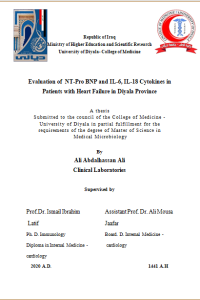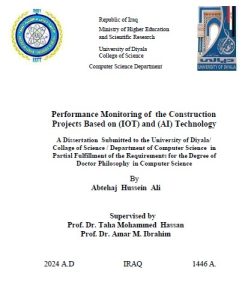Summary
To investigate the common zoonotic bacteria that contaminated meat and meat products during handling, processing and transportation, till it reached the consumers, in Diyala province, Iraq. A total 251 samples were collected, 35 sheep's and cow's meat and meat products, 41 samples poultry's meat, and 175 swabs from workers and their equipment that are used in butchery shops, in the period from August, 2019 to April, 2020.
The samples submitted to laboratory investigation to isolate and identified , the contaminated bacteria, according to their cultural morphology and biochemical properties. Count the total viable bacteria. In addition to study the sensitivity of these bacteria to sixteen commonly used antibiotics. Moreover, the pathogenicity of Klebsiella pneumoniae, which was one of the common isolates in current study, was studied in rabbits.
The results revealed that Klebsiella spp., Pseudomonas spp., Staphylococcus spp., E. coli, Salmonella spp., Listeria, Enterobacter, Citrobacter, Proteus spp., Yersinia and Shigella were common isolates. In 175 isolates, from workers and equipment, Klebsiella spp. was the predominant bacteria 44 (25.1%); followed by Staphylococcus spp. 42 (24.0%); E. coli 34 (19.4%); Pseudomonas spp. 26 (14.9%); Proteus spp. 14 (8.0%); Citrobacter and Yersinia each of 8 (4.6%); Enterobacter 7 (4.0%); Streptococcus 6 (3.4%); Salmonella spp. 4 (2.3%); Listeria 3 (1.7%) and Shigella 1 (0.6%).
From sheep's and cow's meat, 22 isolates were isolate, from which , Staphylococcus spp. was the highest, 12 (54.5%); followed by Klebsiella 72 (31.8%); Pseudomonas 6 (27.3%); Listeria 4 (18.2%); E. coli and Salmonella each of 3 (13.6%). From sheep's and cow's meat products 13 isolates were isolated, from Staphylococcus 7 (53.8%); was the highest isolate; followed by Klebsiella 6 (46.2%); Pseudomonas 3 (23.1%); Listeria 2 (15.4%); E. coli, Citrobacter and Enterobacter each of 1 (7.7%). Total isolates from sheep's and cow's meat and meat products was 35; from which Staphylococcus 19 (54.3%); Klebsiella 13 (37.1%); Pseudomonas 9 (25.7%); Listeria 6 (17.1%); E. coli 4 (11.4%); Salmonella 3 (8.6%); Citrobacter and Enterobacter each of 1 (2.9%).
From poultry's meat and meat products 41 isolates was isolated from which , the highest isolate was Staphylococcus 16 (39.0%); followed by E. coli and Salmonella each of 12 (29.3%); Klebsiella and Pseudomonas each of 9 (22.0%); Listeria 7 (17.1%); Citrobacter and Enterobacter each of 5 (12.2%).
The order of the bacterial species isolated from the 251 samples were as the follows: Staphylococcus 77 (30.7%); Klebsiella 66 (26.3%); E. coli 50(19.9%); Pseudomonas 44 (17.5%); Salmonella 19 (7.6%); Listeria 16 (6.4%); Citrobacter and Proteus 14 (5.6%); Enterobacter 13 (5.2%); Yersinia 8 (3.2%); Streptococcus 6 (2.4%) and Shigella 1 (0.4%).
The highest number was of isolates obtained from workers 197/251 (78.5%); then those from poultry's meat and meat products 75/251 (29.9%); and from sheep's and cow's meat and meat products 56/251 (22.3%).
The total number of bacterial isolates was 328 from which there were 134 (40.9%) isolates in a single form, while the remaining were in more than one isolate; two isolates 110 (33.5%) and three isolates 84 (25.6%).
The highest viable bacterial counts was from chicken's raw meat (8.34±0.02 log10 cfu /g ); followed by Roast meat (8.32 ±0.06); sheep's raw meat (8.31±0.03); cow's raw meat ( 8.30 ± 0.07); sausages from chicken (8.29±0.02); hamburger (8.22 ±0.03); liver of chicken (8.20 ±0.03); burger from chicken (8.16±0.06); shawerma from chicken (7.89±0.04); kebab from chicken (7.85±0.05); kebab from meat (7.77±0.05); worker's ear (4.81±0.04) and the lowest count was from worker's hand( 4.78 ±0.07). While coliform count were as follows: chicken 's raw meat (8.27±0.01); roast meat (8.27±0.05); sheep's raw meat (8.24±0.01); cow's raw meat (8.15±0.01); sausage – chicken (8.11±0.08); hamburger (8.08±0.02); liver chicken ( 8.10±0.05); burger – chicken (8.04±0.07) shawerma – chicken (7.79±0.03) ; kebab chicken (7.80±0.01); kebab meat (6.57±0.02); worker's ear (4.79±0.02) and worker's hand (4.72±0.01).
All tested isolates were sensitive to Norfloxacin (Nor 10) and Gentamycin (Cn10) except Listeria. But to Clindamycin (Da10); Cloxacillin (Cx10); Metromidazole (Met 30); Rifampin(RA 54); Amoxicillin (Ax10) ; Piperacillin (Prl 100) all isolates were resist. The tested isolated exhibit a resistant to 2/3 of tested antibiotics (9-12 antibiotics) and Listeria was resist to all tested antibiotics.
Clinically the animals exposed to Klebsiella pneumoniae exhibits signs of anorexia, depression, dyspnea, engorge blood vessels, three of them died. Heart rates and respiratory rates increased, body temperature and body weight non – significantly changed.
Hematologically; Packed cell volume (PCV%) decreased, Hb showed no significant changes. Total leucocyte count significantly increased. Lymphocytes% increased significantly. Heterophils increased in Monocytes significantly increased. Basophils% and Eosinophils% no significant changes.
Postmortem findings: The main gross lesion were: Lung sever, congestion, with presence of fluid and un-clotted blood. Heart, flabby, enlarged, severely congested. Liver enlarged and congested. Patchy hemorrhages on gastric mucosa, sever congestion of gastrointestinal mucous membranes. Kidneys enlarged and congested, with retention of urine.
Histopathologically: Lung showed expansion of alveoli and destruction of the alveolar walls, this referred to pulmonary emphysema. Amyloid present in some area of the lung, Necrosis, destruction of alveoli, hemorrhage in alveolar wall and thickness of alveolar wall in some area lung showed infiltration of the inflammatory cells Heterophils with a few mononuclear cells.
Heart showed infiltration of fibrocytes in the myocardium Liver showed necrotic area, Kupffer cells a rounded glomeruli with the fatty vacuoles, hepatocyte hyperplasia, and presence of fatty change. Kidneys showed infiltration of inflammatory cells (Heterophils), with a few of mononuclear cell (lymphocytes and mesengial cells.
Stomach showed amyloid deposition in the lamina propria with hyperplasia in mucosal gland.. Small intestine showed hemorrhage nearly the microvilli of intestine, and presence of vacuolation in submucosal layer, this result in hemorrhagic enteritis.





